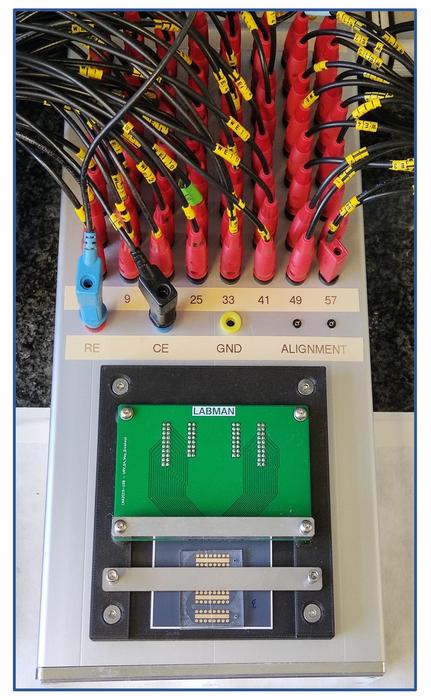As life expectancy increases worldwide, age-associated diseases such as osteoporosis are having an increasing impact. Although early detection could help physicians intervene as soon as possible — when treatment might offer the greatest benefit — this type of detection is not yet possible with current osteoporosis diagnostic tests. Now, researchers reporting in ACS Central Science have developed a biosensor that could someday help identify those most at risk for osteoporosis using less than a drop of blood.

Credit: Adapted from ACS Central Science, 2023, DOI: 10.1021/acscentsci.3c00243
As life expectancy increases worldwide, age-associated diseases such as osteoporosis are having an increasing impact. Although early detection could help physicians intervene as soon as possible — when treatment might offer the greatest benefit — this type of detection is not yet possible with current osteoporosis diagnostic tests. Now, researchers reporting in ACS Central Science have developed a biosensor that could someday help identify those most at risk for osteoporosis using less than a drop of blood.
Early intervention is critical to reducing the morbidity and mortality associated with osteoporosis, a condition characterized by an elevated risk of bone fractures and which affects about 54 million people in the U.S., according to the International Osteoporosis Foundation. The most common technique used to measure changes in bone mineral density (BMD) — dual-energy X-ray absorptiometry — is not sufficiently sensitive to detect BMD loss until a significant amount of damage has already occurred. Several genomic studies, however, have reported genetic variations known as single nucleotide polymorphisms (SNPs) that are associated with increased risk for osteoporosis. Using this information, Ciara K. O’Sullivan and colleagues wanted to develop a portable electrochemical device that would allow them to quickly detect five of these SNPs in finger-prick blood samples in a step toward early diagnosis.
The device involves an electrode array to which DNA fragments for each SNP are attached. When lysed whole blood is applied to the array, any DNA matching the SNPs binds the sequences and is amplified with recombinase polymerase that incorporates ferrocene, a label that facilitates electrochemical detection. Using this platform, the researchers detected osteoporosis-associated SNPs in 15 human blood samples, confirming their results with other methods.
As the DNA does not have to be purified from the blood, the analysis can be performed quickly (about 15 minutes) and inexpensively (< $0.5 per SNP). Furthermore, because the equipment and reagents are readily accessible and portable, the researchers say that the device offers great potential for use at point-of-care settings, rather than being limited to a centralized laboratory. The technology is also versatile and can be readily adapted to detect other SNPs, as the researchers showed previously when identifying drug resistance in Tuberculosis mycobacterium from sputum and cardiomyopathy risk from blood. Although the device does not diagnose osteoporosis itself, it might help physicians identify people whom they should monitor more closely.
The authors acknowledge partial funding from the European Union Horizon 2020 research and innovation programme; and by the Czech Science Foundation.
The paper’s abstract will be available on July 19 at 8 a.m. Eastern time here: http://pubs.acs.org/doi/abs/10.1021/acscentsci.3c00243
For more of the latest research news, register for our upcoming meeting, ACS Fall 2023. Journalists and public information officers are encouraged to apply for complimentary press registration by completing this form.
The American Chemical Society (ACS) is a nonprofit organization chartered by the U.S. Congress. ACS’ mission is to advance the broader chemistry enterprise and its practitioners for the benefit of Earth and all its people. The Society is a global leader in promoting excellence in science education and providing access to chemistry-related information and research through its multiple research solutions, peer-reviewed journals, scientific conferences, eBooks and weekly news periodical Chemical & Engineering News. ACS journals are among the most cited, most trusted and most read within the scientific literature; however, ACS itself does not conduct chemical research. As a leader in scientific information solutions, its CAS division partners with global innovators to accelerate breakthroughs by curating, connecting and analyzing the world’s scientific knowledge. ACS’ main offices are in Washington, D.C., and Columbus, Ohio.
To automatically receive news releases from the American Chemical Society, contact [email protected].
Follow us: Twitter | Facebook | LinkedIn | Instagram
Journal
ACS Central Science
DOI
10.1021/acscentsci.3c00243
Article Title
Genetic Platform for the Multiplexed Targeted Electrochemical Detection of Osteoporosis-Associated Single Nucleotide Polymorphisms using Recombinase Polymerase Solid-Phase Primer Elongation and Ferrocene Modified Nucleoside Triphosphates
Article Publication Date
19-Jul-2023




